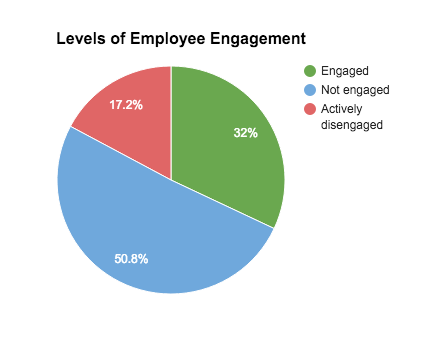Levels of Engagement: Getting the best out of your employees

By John Duval
Losing employees at a rapid clip is a massive drain on a company’s resources (read more on this topic here). It can also be a sign that there’s something really wrong with an organization internally. If exit interviews reveal that employees aren’t just leaving for greener pastures or personal growth opportunities, but because they’re burned out, bored or disgruntled, the cause may be a problem with engagement.
What is employee engagement?
Employee engagement is not the same thing as employee satisfaction or happiness. It’s possible to have satisfied employees— happy to show up at 9 and leave at 5 every day without fail for years— who are not at all engaged in their work. Even in companies with all the fun perks imaginable (casual dress code, happy hours, catered meals, etc.), there are plenty of disengaged employees.
Engagement boils down to an employee’s emotional commitment to their work. An engaged employee understands and believes in the goals of the company. They know their role in reaching those goals, and they believe that role to be integral. According to Gallup, “...employee engagement is strongly connected to business outcomes essential to an organization's financial success, such as productivity, profitability and customer engagement. Engaged employees support the innovation, growth and revenue that their companies need.”
Clearly, this is an aspect of corporate culture worth examining for leadership in any organization. Understanding and monitoring employee engagement is the first step to improving it. First, it’s important to know what to look for. What are the various levels of employee engagement, and what do they look like? There are many methods involving different numbers of levels of engagement. For the sake of simplicity, let’s just look at the three levels Gallup uses when polling the workforce: engaged, not engaged, and actively disengaged.

Engaged
As described above, an engaged employee believes in the goals of the company they’re working for. They have a strong understanding of their role in helping meet those goals, and are therefore willing to use discretionary effort. This means that they’re so absorbed in the work they do and convinced of its importance that they’re willing to put in extra time or effort without being asked. They go the extra mile on behalf of their company’s performance and reputation, just for the satisfaction of participating.
If that sounds like the description of a rare employee, that’s because it is. According to Gallup research, only 32% of employees on average fell into this category. That means that just under one-third of all employees nationwide go to work with a clear purpose and are motivated to fulfill it every day.
Not engaged
This group comprises the largest segment of the workforce, based on Gallup’s findings. A full 50.8% of the population falls into this category. These employees have neither overwhelmingly positive or negative feelings about their work. They’re likely to show up to the office and do the least amount of work necessary to skate by without management intervention. By Gallup’s definition, workers who are not engaged “are less vigilant, more likely to miss work and change jobs when new opportunities arise.”
This segment of the workforce poses a risk to any organization's bottom line. That's because they don't contribute fully, wasting time and resources. They're also more likely to leave for another job when they get frustrated. Since over half of workers in any given company likely meet this description, this is the best place to start improvement efforts. Spending time and resources on re-engaging these employees is usually a worthwhile investment in productivity.
Actively disengaged
This, thankfully, makes up a smaller percentage of the workforce—17.2% in 2015, according to Gallup. But this small group can be an overwhelmingly negative influence on an organization’s success. These employees voice their negative opinions and attitudes about the workplace, undermining any positive morale in their coworkers. Though re-engaging not engaged employees is doable, it’s almost impossible for actively disengaged workers. In those cases, it’s usually best to just end the professional relationship.
Monitoring and improving engagement
Most companies approach the task of monitoring employee engagement by sending out engagement surveys. But the engagement survey process as practiced by most organizations is “not detailed enough, it isn’t real-time, and it doesn’t consider all the work related issues which drive employee commitment,” according to HR expert Josh Bersin.
Furthermore, as Gallup notes, many companies “fall into a common trap of mistaking their survey for an employee engagement strategy. Taking employees through a set of survey questions does not lead to improved engagement.” Monitoring engagement and taking steps to improve it are two entirely different undertakings.
What will work for monitoring and improving engagement in any given company depends entirely on the needs of each organization, but there are some best practices to consider. Any engagement monitoring method should be applied regularly—daily or weekly instead of monthly or quarterly. Staying aware of employee sentiment in real time allows management to take steps to improve morale as issues develop, instead of weeks later, when the problems have had time to escalate.
Likewise, the solutions to poor engagement will vary based on company goals and culture. The key to improving engagement, though, is to take the process seriously. Leadership needs to view it as a necessary component of the business plan, and prioritize it accordingly. Only with examination and effort will employee engagement improve.






